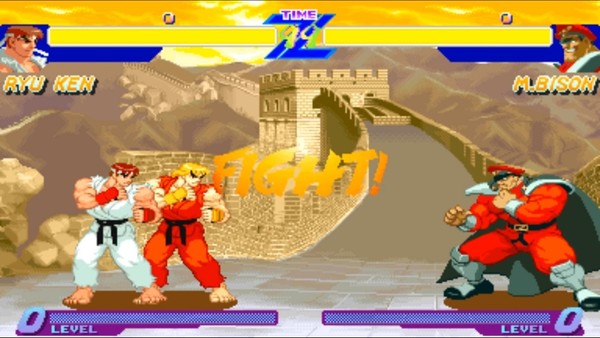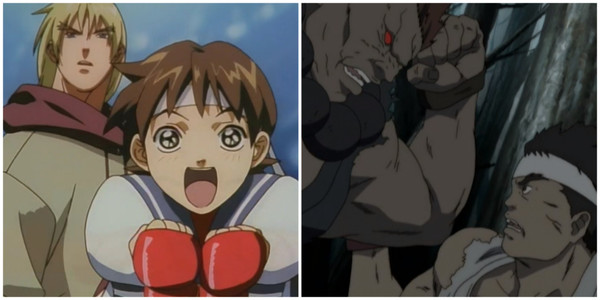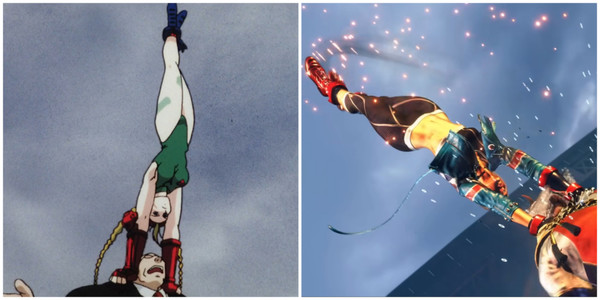The Anime Road To Street Fighter
by Christopher Farris,The return of Cammy White in her debut trailer trailer for Street Fighter 6, and her new design, has caught the attention of plenty of players and fan artists. However, one of the moves Cammy showed off also turned the heads of a whole other set of Street Fighter fans in the audience, as her new Super move sees her perform the exact spine-rearranging spin the character used on a senator in her appearance at the beginning of Street Fighter II: The Animated Movie. For some, this might seem like a surprisingly deep cut, but those in the know are aware it is far from the first time the Street Fighter games have referenced that movie. The fact is, Street Fighter has a whole legacy of interconnections between its games and other anime projects which spun out of that first anime film!
Video game to anime adaptations can be contentious but ask Street Fighter fans, and they'll generally agree that Street Fighter II: The Animated Movie is one of the strongest jobs. Released in August of 1994, when Street Fighter II as an institution was still riding high atop the fighting game wave it had ushered in, The Animated Movie comes off as a concerted effort by writer Kenichi Imai, director Gisaburou Sugii, and production at Group TAC to cram absolutely everything that appealed from the games into a single anime film. And rather astonishingly, they succeed!

The movie manages to include every single fighter from Super Street Fighter II Turbo in some capacity. Some are more fleeting than others, like Blanka and Zangief only popping up for an exhibition match in Las Vegas or Akuma's infamous cameo selling oranges by the side of the road. But it's all generally used to great effect, telling Ryu's tale of traveling and training his fighting abilities, interwoven with Chun-Li and Guile's efforts to track down Bison's criminal organization. Characters like Ken and E. Honda eventually also get involved, regularly selling the idea of unsanctioned, spontaneous brawls (like some sorts of fights that take place on streets) while also working in the globe-trotting mechanics of the game.
Street Fighter II: The Animated Movie is not known for being an especially deep film, with a brisk runtime that still feels padded out at times. But it stood out at the time thanks to its focus on making the fights entertaining and, perhaps more importantly, a dedication to really feeling like Street Fighter. The characters are all instantly recognizable from their game designs, with special moves faithfully reproduced and regularly deployed across the battles in the movie. It also fleshed out some of the Street Fighter cast more than they'd ever had at the time, particularly the pasts of Ryu and Ken and the dynamics of their relationship. Unsurprisingly, it remains the most easily accessible of Street Fighter anime projects. The movie is available streaming on platforms like Amazon and Crunchyroll, to be viewed in both its original Japanese version, as well as its English dub (which not only swapped out much of the soundtrack for bands like Korn and Alice in Chains but amusingly includes Bryan Cranston as the voice of Fei-Long!). Discotek also put out one of their expectedly-comprehensive Blu-ray releases in 2016. The success of The Animated Movie would see it go on to be continuously influential, not just on the fandom, but on the ongoing franchise itself!
Before I get into everything else which spun out of The Animated Movie, I must talk about the very first follow-up, both because of its placement and how bizarre it is. You see, starting in March 1995, an exhibition was held celebrating Fujiwara-kyō, historically considered to be the first real capital of Japan. One of the partners for the event was none other than Capcom, and as a tie-in, they produced Street Fighter II: Yomigaeru Fujiwara-kyō - Toki wo Kaketa Fighter-tachi. This OVA ostensibly follows on from The Animated Movie due to its success the prior year, though almost none of the crew or voice cast from that return, with this one animated by Studio Pierrot instead. It is effectively an edutainment piece, hurling Ryu, Ken, Chun-Li, and E. Honda back in time to learn what life was like in those early years in Fujiwara. As a "lost" Street Fighter anime, only having a couple of small print runs and not even seeing an English-fansubbed upload until a couple of years ago, its existence is fascinating, and it will always merit a mention when I'm talking about these things.

Street Fighter is no stranger to recursive adaptations. But unlike the ill-fated digitized-sprite cash-in of Street Fighter: The Movie: The Game (ability to play as Raul Julia notwithstanding), The Animated Movie did well enough not just to inspire a game, but multiple games. Okay, one was Street Fighter II MOVIE, a console FMV game that sees the player taking control of one of the film's monitor cyborgs to…basically watch the movie. More pertinently, the movie was the inspiration for Capcom's Street Fighter Alpha series, the next line in the fighting franchise after the Street Fighter II updates had run their course. Alpha not only adopts a more stylized look in line with the movie's art, it directly adapts elements for the characters and plots that the film introduced. It includes things like the backstory of Ken being the one to gift Ryu his iconic red headband or special game modes which recreate the famous Ryu and Ken team-up battle against Bison from the end of the movie.

Working off of that Ken and Ryu backstory bit, the Alpha games were designated as a prequel to what had been told through the previous Street Fighter II. Only a little coincidentally then, in 1995, the same year Alpha launched, another project spun out of the success of The Animated Movie debuted: Street Fighter II V, an anime TV series from the same team that had put together the film. Despite having the same writer/director combo and being animated by the same studio, with the fights, in particular, carrying much of the same vibe, Street Fighter II V is unconnected, story-wise, to the movie. It also takes the prequel approach of Alpha but goes in very different directions with its story and characters. Notably, virtually everyone has been redesigned to some degree, with Ryu sporting a spiky-haired, headband-less look, Ken being a redhead, and Chun-Li looking the part of a spunky Hong Kong tour guide. Everyone's pointedly younger, and one can potentially see these takes on some of the characters growing into the now-familiar, established versions. As a show on its own, Street Fighter II V is neat and continues to embody that dedication to the street fighting style the movie kicked off. But its status as an evolutionary dead end for a prequel takes on the Street Fighter story renders it but a curiosity within the franchise's broader influences. As of this writing, it's not even available for streaming anywhere in English. The more accurate hewing of The Animated Movie, and thus its game-based spawn in Alpha, simply won out.

That Street Fighter Alpha series ran for three numbered installments, each of them also getting upgrades and alternate versions across consoles. Carrying on the legacy of The Animated Movie, the Alpha line would prove hugely influential to the ongoing evolution of Street Fighter. This is the series that introduced Sakura Kasugano, fan-favorite street-fightin' schoolgirl, whose own spin-off manga introduced the likes of Karin Kanzuki, who herself became so popular she got added into the video games! Again, recursive. Even more so when you find out that these games, already based on an anime movie based on a video game, themselves inspired their own anime movies! Two of them, even!
The first was the 2000's Street Fighter Alpha: The Animation. Still animated by Group TAC, this one was directed by Shigeyasu Yamauchi and written by Reiko Yoshida, a real workhorse within the industry who also wrote the Virtua Fighter anime, as well as a whole bunch of the Digimon movies. But the real draw has got to be Yoshihiko Umakoshi on designs and animation direction. Umakoshi lends the Alpha OVA an exuberant sense of style, which feels like it's pushing the look of Street Fighter to the natural next stage after the anime evolution started with The Animated Movie. The story in this one does have a few odd spots, making use of more original character concepts while still working to include many of the fighters from the first two Alpha games. But it's still absolutely worth watching for its looks and some of its more raw takes on things like the mindsets of people who engage in fighting on the streets, and it helps that it's freely available on Tubi. It feels like something of a hidden gem that doesn't get discussed nearly as regularly as that Street Fighter II anime movie, despite clearly coming from the same lineage.

The same, unfortunately, can not be said about the other Alpha anime entry: 2005's Street Fighter Alpha: Generations. This 2005 release, produced by A.P.P.P. specifically for the English market, is a messy, misguided affair. The animation aims for a more "realistic" look compared to the increasing stylization of Studio TAC's efforts, yet still dissolves into uncalculated ugliness when it's trying to up the intensity of the fights. This is "complemented" by some incredibly limp digital effects for attacks like the Hadouken, as well as an English dub that sounds downright atrocious most of the time, despite sharing several previous actors with the other movies! A direction problem, to be sure, and that's not even getting into the dire, droning attempt at a story attempting to fill up its scant 45-minute runtime. This one's also free to watch on Tubi if you're morbidly curious. And to its credit, Alpha: Generations makes it abundantly clear how good we really had it with the Studio TAC run of Street Fighter anime, and at least fits right in as a representation of the rough place the Street Fighter franchise was in during the mid-2000s. So that's something.
It also marks the end of the road for Street Fighter anime that act as anything approaching transformative adaptations. The only other anime projects for the franchise would come about starting with its big video game comeback in Street Fighter IV. The Collector's Edition of the console release of that game in 2009 included The Ties That Bind, an hour-long feature animated by Studio 4°C. As well, there were four animated shorts produced as promotion for the game. And while The Ties That Bind can be alright, it ultimately comes off purely as the bonus that it is, effectively passing for an extra-long introductory cutscene to Street Fighter IV's in-game story. The upgraded Super Street Fighter IV pulled a similar move when it was released in 2010, the Xbox 360 Collector's Edition, including a special OVA animated by Studio Gonzo of all people, showcasing the origin of the new hotness character Juri Han. So ancillary was this bonus considered, it didn't even make it into an English release until 2012 when it was included as an extra in the unnecessarily lavish Street Fighter 25th Anniversary Collector's Set. That remains the only official way to see the special in English, which is honestly a pity since it ain't bad. Definitely better than Alpha: Generations and The Ties That Bind.

It certainly says something that these sorts of Street Fighter anime projects effectively wound up buried, while The Animated Movie, which started it all, continued to see references and callbacks going forward. Even companies that weren't Capcom would get in on the action. When the company's erstwhile rival SNK produced SNK vs. Capcom: SVC Chaos in 2003 as part of their compounding crossover clashes, one "new" character it included was "Violent Ken," a take-off on the mind-controlled Ken from the last act of the movie. Fifteen years later, Capcom would adopt Violent Ken into gameplay themselves, including him as one of the titular Final Challengers in the 2017 Switch release of Ultra Street Fighter II. The other new character was, naturally, Evil Ryu, who spun out of the Alpha games begat by The Animated Movie.
But to trace the effective lineage of that first anime film, you only need to follow Cammy, the one whose Street Fighter 6 reveal started us down this road. Cammy's original Street Fighter II story detailed her past connection to M. Bison but with no mention of mind control. But so memorable was her brainwashed assassination at the beginning of The Animated Movie, in a story that made a whole plot device out of the mechanic, that Cammy's mind-manipulated past would become the defining feature of her character once she and her origin appeared in the Alpha series. They even gave her a battle intro animation casting off a big coat like in that movie. That detail would also come up in several of those other anime projects I touched on, as Cammy throwing off a coat is just an iconic™ element of her character now. So perhaps the most surprising part is that the spinning neck-snap move she does right after that coat-toss in the movie didn't make it into the games until we saw it in Street Fighter 6 here. But if there's still material to mine from that famous movie, it only proves that the anime road to these fighting streets really can go on forever.

discuss this in the forum (7 posts) |